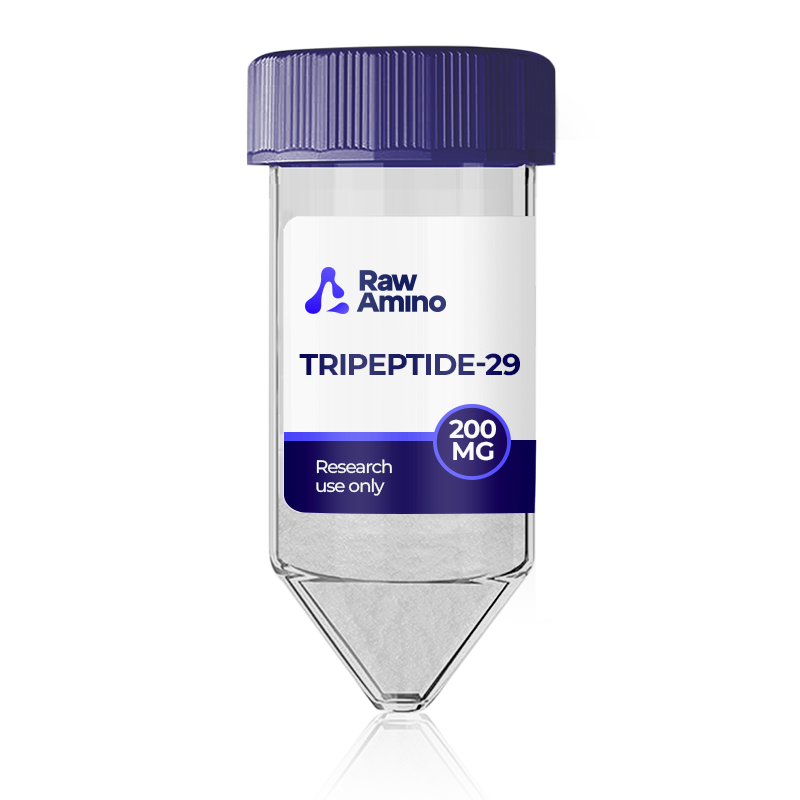
Tripeptide-29 – 200MG
$184.00
Discount per Quantity
| Quantity | Discount | Price |
|---|---|---|
| 5 - 8 | 5% | $174.80 |
| 9 + | 10% | $165.60 |
Scientific Overview of Tripeptide-29
Tripeptide-29 is a synthetic tripeptide modeled on repeating collagen motifs. Collagen is composed of short amino acid sequences that assemble into complex structures, which may contribute to structural resilience in various tissues such as bone, tendons, and the dermal barrier. Tripeptide-29 reflects one of the common repeating units found in collagen, and has been investigated in experimental studies for its potential influence on processes such as matrix stability, oxidative regulation, coagulation activity, and tissue remodeling.
Alternative Names: Gly-Pro-Hyp peptide, Collagen-derived tripeptide
Tripeptide-29 Studies and Research Data
Investigations into Fibrosis and Enzyme Modulation
Laboratory models suggest that Tripeptide-29 may interact with dipeptidyl peptidase IV (DPP4), an enzyme associated with the breakdown of bioactive peptides and processes linked to fibrosis. Research indicates that inhibition of this enzyme could reduce excessive connective tissue buildup in experimental systems. Findings point to Tripeptide-29 as a potential contributor in studies exploring scarring and fibrotic progression.
Tripeptide-29 Structural Contributions to Collagen Stability
Research on short peptide fragments proposes that the hydroxyproline residue present in Tripeptide-29 may help strengthen collagen fibrils. Observations suggest that this structural component appears to promote favorable molecular interactions, reduce degradation under UV exposure, and possibly enhance the resilience of collagen. Such findings contribute to understanding how minor sequence changes may impact macromolecular stability.
Tripeptide-29 Explorations in Coagulation Pathways
Experimental platelet models indicate that Tripeptide-29 may act as a partial agonist of the collagen receptor GPVI. This interaction appears to stimulate phosphorylation signaling cascades that are commonly observed in platelet activation. Such responses may be valuable in better understanding mechanisms of clot initiation and vascular repair in controlled research conditions.
Oxidative Stress and Aging Mechanisms
Several studies suggest that Tripeptide-29 may act as a scavenger of reactive oxygen species, potentially lowering oxidative stress. Researchers have also proposed that it may influence the accumulation of advanced glycation end products (AGEs), compounds considered to accelerate tissue aging. Findings suggest that by influencing these processes, Tripeptide-29 may help illuminate cellular pathways relevant to dermal aging and structural decline.
Tripeptide-29 Experimental Research on Dermal Models
Pilot investigations exploring tripeptides, including Tripeptide-29, have reported observations linked to hydration, elasticity, and contour in skin models. Experimental reports suggest reduced irregular pigmentation and improved dermal uniformity, with some studies noting enhanced flexibility and moisture compared to baseline conditions. These outcomes highlight the continued research interest in tripeptides for dermal investigations.
Conclusion
Tripeptide-29 has been studied in multiple laboratory contexts, ranging from collagen structure and oxidative processes to platelet activity and fibrosis pathways. Research findings suggest that this tripeptide may contribute to broader understanding of how short peptide motifs influence stability, signaling, and cellular responses. Continued investigations may clarify its role as a model compound in collagen-related and dermal-focused research.
References
- Abedin MZ, Karim AA, Latiff AA, et al. Biochemical and radical-scavenging properties of sea cucumber collagen hydrolysates. Nat Prod Res. 2014;28(16):1302-1305.
- Mizuno K, Peyton DH, Hayashi T, Engel J, Bächinger HP. Effect of hydroxyprolyl tripeptide units on stability of collagen model peptides. FEBS J. 2008;275(23):5830–5840.
- Lee YI, Lee SG, Jung I, et al. Effect of a collagen tripeptide on skin aging and glycation. Int J Mol Sci. 2022;23(3):1101.
- Min HS, Kim JE, Lee MH, et al. Dipeptidyl peptidase IV inhibitor protects against renal fibrosis in a mouse model. Lab Invest. 2014;94(6):598-607.
- Jariashvili K, Madhan B, Brodsky B, et al. UV damage of collagen: insights from model peptides. Biopolymers. 2012;97(3):189-198.
- Reivitis A, Karimi K, Griffiths C, Banayan A. A pilot study evaluating a TriHex peptide- and botanical-containing eye formulation. J Cosmet Dermatol. 2018;17(3):467-470.
- Garre A, Martinez-Masana G, Piquero-Casals J, Granger C. Redefining face contour with a cosmetic peptide formulation: an open-label study. Clin Cosmet Investig Dermatol. 2017;10:473-482.
- Asselin J, Knight CG, Farndale RW, Barnes MJ, Watson SP. Collagen-like motifs as partial agonists of GPVI. Biochem J. 1999;339(2):413-418.
- Hatanaka T, Kawakami K, Uraji M. Inhibitory action of collagen-derived tripeptides on dipeptidylpeptidase-IV. J Enzyme Inhib Med Chem. 2014;29(6):823-828.
- Némethy G, Scheraga HA. Stabilization of collagen fibrils by hydroxyproline. Biochemistry. 1986;25(11):3184–3188.
Disclaimer:
The products mentioned are intended solely for laboratory research and in-vitro experimentation. They are not approved for human or animal use of any kind. All details provided are for educational purposes only. By purchasing from this site, you agree to comply with our Terms and Conditions.
Only logged in customers may leave a review.
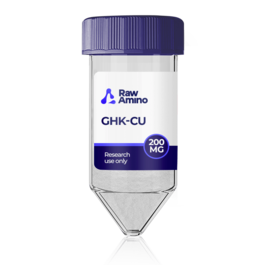
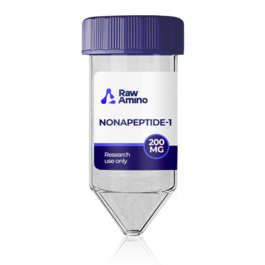
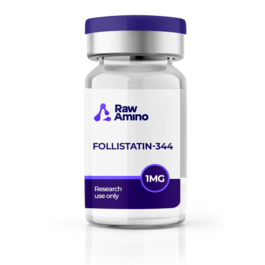
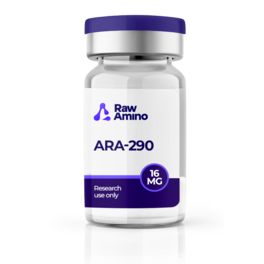
Reviews
There are no reviews yet.